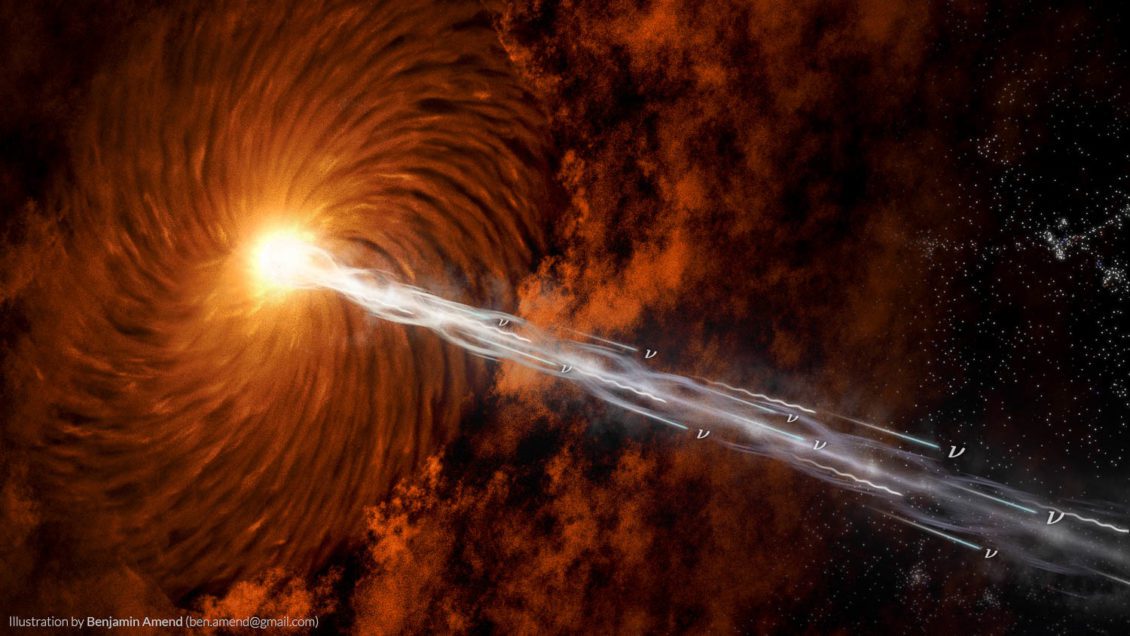
Astrophysicists prove neutrinos originate from blazars
Cosmic rays, charged particles that travel up to nearly the speed of light from deep outer space, constantly bombard Earth.
For more than a century, astrophysicists have tried to determine the origin of those extremely energetic particles, which are up to a million times more energetic than anything achieved by the world’s most powerful particle accelerator, the Large Hadron Collider near Geneva, Switzerland. They also want to know what propels them with such tremendous force.
Solving the age-old mystery could be one step closer thanks to new multi-messenger research by a team of scientists that includes Clemson University Associate Professor of Physics and Astronomy Marco Ajello.
Ajello and collaborators Sara Buson from Julius-Maximilians-Universität (JMU) Würzburg in Bavaria, Germany, and Andrea Tramacere from the University of Geneva have proven with an unprecedented certainty that astrophysical neutrinos originate from blazars.
Tiny particles
Astrophysical neutrinos are tiny neutral particles produced by cosmic ray interactions in these extreme accelerators, making them unique messengers, or signals, that could help pinpoint cosmic ray sources.
Because cosmic rays are charged particles, the galaxy’s magnetic fields can deflect them during their journey through space. That makes it impossible for scientists to trace where they originated. Neutrinos, on the other hand, have very little mass, are neutral and hardly interact with matter. They race through the universe and can travel through galaxies, planets and the human body almost without a trace. Because electromagnetic forces do not affect them, they can be traced back to their astrophysical sources.

In 2017, the IceCube Neutrino Observatory, buried deep in the ice at the South Pole, detected a neutrino. Scientists traced it back to blazar TXS 0506+056. Blazars are active galactic nuclei powered by supermassive black holes that emit much more radiation than their entire galaxy. The publication in the journal Science sparked a scientific debate about whether blazars are cosmic ray accelerators.
Using neutrino data obtained by IceCube — the most sensitive neutrino detector currently in operation — and a catalog of astrophysical objects confidently identified as blazars, Ajello and his colleagues found powerful evidence that a subset of blazars originated the observed high-energy neutrinos. Their findings, published in The Astrophysical Journal Letters, report the probability of this being coincidence is less than one in a million.
“We had a hint back then (in 2017), and now we have evidence,” Ajello said.
“The results provide, for the first time, incontrovertible observational evidence that the sub-sample of PeVatron blazars are extragalactic neutrino sources and thus cosmic ray accelerators,” Buson said. PeVatron blazars speed up particles up to at least PeV energies. PeV is 10^15 electron-volts.
Major milestones
The discovery of these high-energy neutrino factories represents a major milestone for astrophysics, according to Tramacere. “It places us a step forward in solving the century-old mystery of the origin of cosmic rays,” he said.
Ajello said researchers will now study those blazars to understand what makes them good accelerators.

Buson said the statistical analysis has focused only on the most promising sets of IceCube neutrino data. She expects that further sophisticated analytical techniques may bring more discoveries.
The research also illustrates the importance of multi-messenger astronomy, Ajello said. Multi-messenger astrophysics is one goal in the National Academies’ “Pathways to Discovery in Astronomy and Astrophysics for the 2020s,” a report that sets research priorities for the astronomy and astrophysics communities for the next decade.
For thousands of years, astronomers and astrophysicists relied on light to study the universe. But they can now detect other “messengers” such as cosmic rays, neutrinos and gravitational waves.
“It’s like feeling, hearing and seeing at the same time. You’ll get a much better understanding,” Ajello said. “The same is true in astrophysics because the insight you have from multiple detections of different messengers is much more detailed than you can get from only light.”
The European Research Council has funded the described work within the framework of a Starting Grant, PI Sara Buson. ID: 949555, “Mapping Highly-Energetic Messengers across the Universe” (MessMapp). Part of Ajello’s work on the project was funded by NASA under contract 80NSSC21K1915.
This article includes information from a media release by Julius-Maximilians-Universität Würzburg.
The College of Science pursues excellence in scientific discovery, learning, and engagement that is both locally relevant and globally impactful. The life, physical and mathematical sciences converge to tackle some of tomorrow’s scientific challenges, and our faculty are preparing the next generation of leading scientists. The College of Science offers high-impact transformational experiences such as research, internships and study abroad to help prepare our graduates for top industries, graduate programs and health professions. clemson.edu/science
Get in touch and we will connect you with the author or another expert.
Or email us at news@clemson.edu
